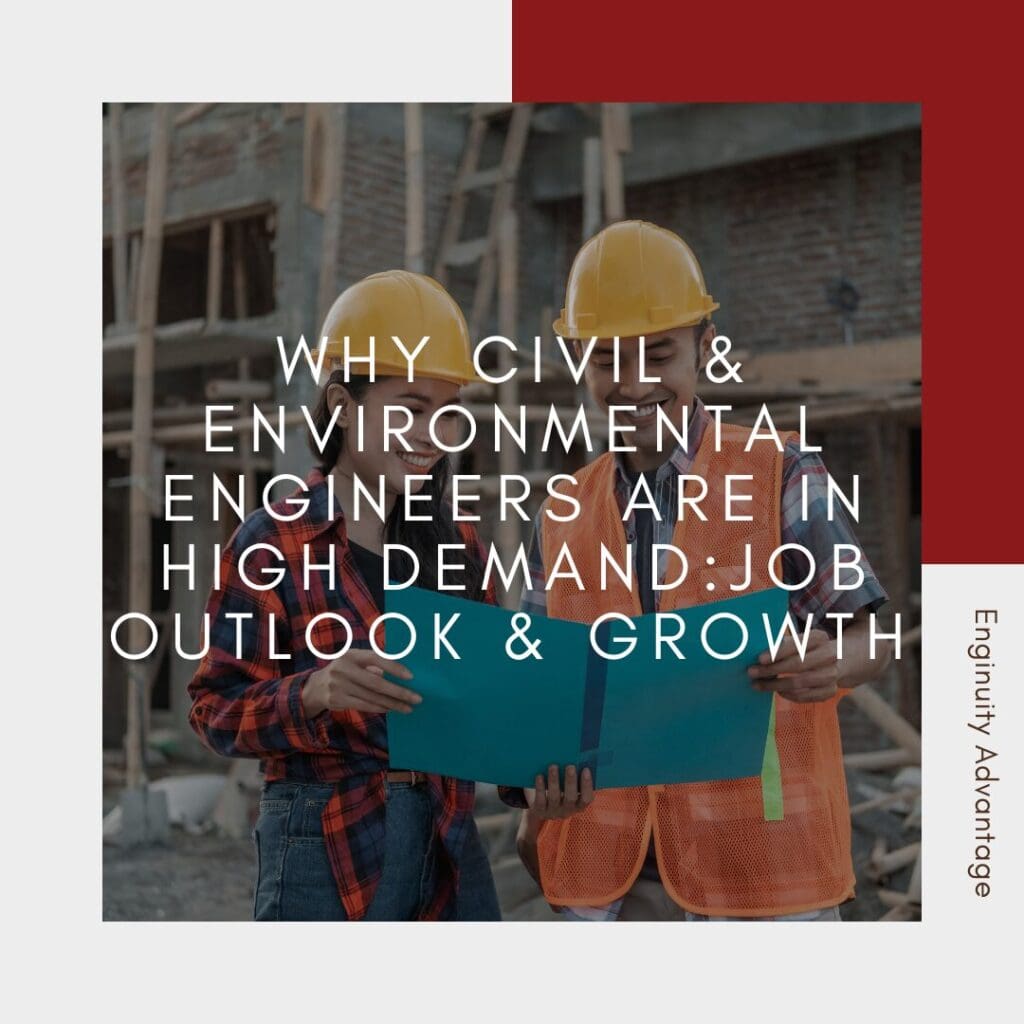Why Civil & Environmental Engineers Are in High Demand: Job Outlook & Industry Growth

The world is at a critical juncture. As infrastructure ages, populations grow, and climate challenges intensify, the need for sustainable, intelligent development has never been more urgent. At the heart of these efforts are civil and environmental engineers, professionals uniquely equipped to design, build, and maintain the systems that sustain modern life while protecting the natural world.
Civil and environmental engineering are not just fields in transition; they are at the epicenter of a global transformation. The increased emphasis on resilience, climate adaptation, public health, and smart infrastructure has elevated demand for engineers with the vision and technical expertise to shape a more sustainable future.
This article explores why civil and environmental engineers are in such high demand, what the future holds for the profession, and how this trend is influencing both the job market and the built environment.
Infrastructure Investment and the Need for Skilled Engineers
Across the globe, infrastructure systems are showing signs of stress. Roads, bridges, water systems, and public transportation networks are operating well beyond their intended lifespans. Governments and private sectors are responding with massive investments in infrastructure revitalization and expansion.
In the United States, legislation like the Infrastructure Investment and Jobs Act has earmarked hundreds of billions of dollars for upgrades to roads, bridges, airports, transit systems, and water infrastructure. This surge in funding has created an unprecedented demand for civil engineers who can manage, design, and oversee these complex projects.
These investments also reflect a shift toward more sustainable and equitable development. Projects increasingly require a balance between efficiency, resilience, and environmental stewardship. Civil and environmental engineers are expected to lead the way, applying new technologies, materials, and analytical tools to build smarter and cleaner systems.
As hiring ramps up, firms are seeking engineers who are not only technically proficient but also agile communicators and interdisciplinary collaborators. Organizations like Enginuity Advantage are playing a vital role in helping companies identify and recruit the talent needed to deliver on these transformative goals.
Climate Adaptation and the Rise of Environmental Engineering
From rising sea levels to record-breaking heatwaves and more frequent natural disasters, climate change is driving new responsibilities for engineers. Environmental engineers are at the forefront of developing strategies that reduce emissions, protect natural resources, and ensure infrastructure can withstand a rapidly changing climate.
Green infrastructure, stormwater management, and climate-resilient design are becoming core components of both urban planning and industrial development. Engineers are designing wetlands to manage floodwaters, developing sustainable landfills that limit methane emissions, and advising on low-impact development techniques that harmonize with natural ecosystems.
This evolving role is not limited to coastal or high-risk areas. Engineers everywhere are being asked to evaluate risks and propose solutions that account for climate projections, regulatory requirements, and community needs. As a result, demand for environmental expertise is rising across sectors—from energy and transportation to agriculture and manufacturing.
The Digital Transformation of Engineering
Digital technologies are transforming civil and environmental engineering. Building Information Modeling (BIM), Geographic Information Systems (GIS), artificial intelligence, and real-time sensor data are giving engineers new ways to visualize, simulate, and optimize their designs.
In civil engineering, BIM is streamlining project coordination across disciplines and life cycles. Environmental engineers are leveraging AI for pollutant modeling and risk assessment. Drones and remote sensing tools are expanding the scope and precision of environmental monitoring.
This technological evolution is reshaping job roles. Employers now seek engineers who are digitally fluent—comfortable working in multidisciplinary digital environments and eager to adopt new tools. Firms that support this evolution, often with help from organizations like Enginuity Advantage, are seeing faster project delivery, better compliance outcomes, and more innovative designs.
The rise of “smart infrastructure” is further driving demand. Whether it’s bridges that monitor their own stress levels or green buildings that adapt to environmental conditions, today’s engineering workforce must integrate software, sensors, and sustainability in ways that redefine traditional boundaries.
Job Outlook by Region and Sector
The job outlook for civil and environmental engineers varies by region and industry, but the overarching trend is clear: demand is growing. Urban areas undergoing rapid expansion, coastal regions adapting to sea-level rise, and communities investing in renewable energy and water systems are all hotspots for engineering activity.
Public and private sector opportunities are abundant. Municipal governments are hiring engineers for transportation planning and public works, while private firms need professionals for commercial development, environmental consulting, and infrastructure design. The U.S. Bureau of Labor Statistics projects steady growth in both fields, with particularly strong prospects for engineers who specialize in green building, stormwater systems, and sustainable transportation.
Emerging economies are also seeing increased demand for infrastructure development, particularly in areas such as clean water access, energy efficiency, and waste management. As a result, international opportunities are expanding for engineers with global experience and adaptability.
Engineering Ethics and Social Responsibility
Today’s engineers must navigate more than technical blueprints—they must also consider the ethical implications of their designs. Environmental justice, community engagement, and transparent decision-making are becoming central to engineering practice. Civil and environmental engineers are increasingly expected to advocate for underserved communities and ensure equitable access to infrastructure and resources.
Ethical challenges may arise in land development, water usage, emissions control, or environmental remediation. Engineers must balance economic constraints with public safety, ecological preservation, and community values. Ethics training and continuing education are growing areas within professional development, helping engineers uphold their responsibilities in a changing world.
Hiring professionals who bring not just expertise, but also integrity and ethical foresight, is now a priority for many organizations. Recruiting partners like Enginuity Advantage are responding to this need by identifying candidates who align with a firm’s mission and commitment to social impact.
Workforce Diversity and Inclusion in Engineering
The engineering field has long struggled with the underrepresentation of women and minorities. However, as firms recognize the benefits of diverse teams, including improved innovation, problem-solving, and stakeholder engagement—diversity and inclusion have become strategic priorities.
Efforts to expand access to engineering careers are being supported through outreach programs, scholarships, mentorship initiatives, and hiring practices that prioritize equity. Civil and environmental engineering offer particularly strong platforms for diversity, as these roles are often community-focused and deeply tied to societal outcomes.
Career Pathways and Specializations
The career paths within civil and environmental engineering are more varied than ever before. Civil engineers may specialize in structural design, transportation systems, construction management, or hydrology. Environmental engineers might focus on air quality, hazardous waste, water treatment, or climate risk mitigation.
Specialization allows engineers to dive deep into their passions while contributing meaningfully to global goals like sustainability and resilience. Advanced degrees, certifications, and cross-training are increasingly important in shaping careers and expanding professional impact.
Employers are looking for professionals who not only master technical skills but also show leadership, adaptability, and a commitment to lifelong learning. Supporting these career pathways through training, mentorship, and professional development is a key factor in long-term success for both individuals and firms.
Public Health and Water Quality Engineering
A critical but often overlooked area where civil and environmental engineers are making a significant impact is public health—specifically, through the design and maintenance of water supply and sanitation systems. Engineers are working to ensure that communities have access to clean drinking water, safe wastewater treatment, and reliable stormwater infrastructure.
As water scarcity becomes a growing issue globally, engineers are playing a central role in developing sustainable desalination systems, greywater recycling technologies, and water reuse strategies. Their expertise also helps prevent the spread of waterborne diseases by designing systems that maintain high hygiene standards even in densely populated or resource-limited areas.
This intersection of engineering and public health is expected to grow in importance, particularly as global health trends, climate change, and aging infrastructure converge. Engineers capable of integrating public health priorities into technical design are in high demand, particularly in roles that collaborate with municipalities, health departments, and nonprofit organizations.
Resilient Infrastructure and Disaster Mitigation
Natural disasters, including floods, wildfires, hurricanes, and earthquakes—are increasing in frequency and severity. Civil and environmental engineers are leading efforts to design infrastructure that not only survives these events but actively mitigates their impact.
This includes designing buildings that can withstand extreme weather, creating evacuation routes and stormwater systems that prevent urban flooding, and reinforcing critical facilities such as hospitals, fire stations, and schools. Engineers are also using risk assessment tools and GIS mapping to identify vulnerable regions and prioritize upgrades.
The demand for professionals who specialize in disaster-resistant design is rising across the globe. As governments and insurers place a premium on resilience, engineers who understand both the technical and regulatory frameworks of disaster mitigation are becoming invaluable assets in planning, design, and response.
Emerging Roles in Circular Economy and Sustainable Materials
The concept of a circular economy, where resources are reused, recycled, and reimagined instead of discarded, is redefining how infrastructure is designed. Engineers are increasingly tasked with selecting low-impact, recyclable, or biodegradable materials that reduce the environmental footprint of construction projects.
In both civil and environmental engineering, the emphasis on lifecycle analysis is changing how projects are conceived. Engineers must now consider end-of-life reuse, disassembly, and materials recovery. New roles are emerging in areas like construction waste management, regenerative design, and closed-loop systems.
Looking Ahead: Engineering the Future
The future of civil and environmental engineering is as promising as it is demanding. Engineers will play a defining role in addressing the planet’s most urgent challenges, climate change, urbanization, population growth, and resource scarcity. Meeting these challenges requires a new kind of engineer: one who is collaborative, creative, and ethically grounded.
Firms that embrace this future are investing in culture, innovation, and purpose-driven work. They’re building teams that value diversity, seek continuous learning, and prioritize long-term impact over short-term gain. And they’re partnering with organizations like Enginuity Advantage to find the talent needed to turn vision into reality.
Whether revitalizing a city’s infrastructure, protecting a water source, or designing for the next generation of sustainable communities, civil and environmental engineers are no longer working behind the scenes. They are at the front lines of change, designing a better world from the ground up.
Unlock Dream Careers & Elite Talent: Just One Click Away!


